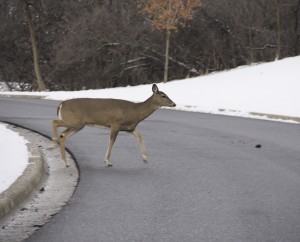
The Gallup Park has been closed in Ann Arbor because of a deer culling. Colin MacDougall | Washtenaw Voice
BY COLIN MACDOUGALL
Contributor
As students returned to campus for classes last week, United States District Judge Aaron Tarrow made the decision to bring in sharpshooters to cull the deer population in Ann Arbor. Tarrow made the conclusion that hiring sharpshooters to hunt in the city would be better than “traditional hunters with carrots and six-packs of beer” and that the public was in “no immediate danger,” according to the Detroit Free Press.
A lawsuit against the city-sanctioned plan to cull the deer had been brought up on Monday, Jan. 11 trying to halt Ann Arbor City Council’s decision in moving forward with the culling. The plaintiff of Ann Arbor, Sabra Sanzotta, felt that the cull will put lives in danger with the United States Department of Agriculture Wildlife Services sharpshooters firing guns into the neighborhoods of Ann Arbor.
Starting Jan. 1 – Mar. 1, the Deer Management Program is in effect. This comes from a decision made by the Ann Arbor City Council who voted back in August with an overwhelming 8-1 vote in favor of bringing in sharpshooters. The culling of the deers will occur in the city parks from 4 p.m. to 7 a.m. January and February. The city’s parks will be closed during these times.
“This was a two year process,” said Lisa Wondrash, Ann Arbor’s communications director. “The city administrator at the time had been directed to look into deer management options. He presented a report to the city council that included research that had been done and deer management in other communities.”
Wondrash also noted that, “City staff held three meetings, dozens of stakeholder meetings, conducted two open City Hall surveys, two aerial surveys and with that resulting in May of 2015, the deer management recommendation report.”
Protests of the city council’s decision have now been going on for months, led by the group known as the Friends of Ann Arbor Wildlife and Nature.
At first, 24 parks were to be closed, but on Wednesday, Jan. 13, the city announced that it would drop 10 parks from the list.
Karen Patterson, the director of humane education for the Huron Valley Humane Society, says that there is no need for the cull and the issue was brought up by residents who were upset with deer eating their landscaping.
“We have yet to see data showing any problem with deer in Ann Arbor that demands such a drastic, immediate, violent and costly response by the city as a whole,” Patterson said.
She noted that “Two aerial surveys were done in the winter of 2015 by the city of Ann Arbor. The highest count was 168 deer, which averages only six deer per square mile. According to the Ann Arbor City Council report, Michigan Natural Feature Inventory biologists recommend deer densities of 15-20 deer per square mile.”

Washtenaw is known to have deer that wonder it’s campus. Gray Bancroft | Washtenaw Voice
The sharpshooters the city hired to from the USDA Wildlife Services were brought in to cull 100 deer this season. The city council has also signed on to continue to cull the deer for the next four years, according to the city council agenda.
“USDA Wildlife Services is very controversial and has been discovered to use a lot of cruel, inhumane practices that violate their policies,” Patterson said.
Ann Arborites from Washtenaw Community College weighed in on the controversy. Katie Holt, a 19-year-old liberal arts major of Ann Arbor, disagreed with the judge’s decision noting that the city of Ann Arbor is a progressive city whose name “stands for Tree City.” Holt feels that along with the nickname, the wildlife belongs with it.
“I’m worried about people being injured or shot accidentally,” said Rosie Van Alsburg, a 16-year-old student and president of WCC’s Political Science Club. “The sterilization option is a better idea — it won’t harm the deer, but their would be less of them.”
Deer can cause several problems for communities. They can carry Lyme disease which is an infectious disease that can be transferred from deer to humans through deer ticks. Also, deer collisions can be fatal for both the deer and the driver.
Patterson disagrees and says, “Ann Arbor is not identified as being a risk area for contracting Lyme disease, and the rate of deer vehicle collisions has actually decreased in recent years.”
Some people justify the cull because of the deer being fed to the needy in the Ann Arbor community, but Patterson points out,“If the funds used to kill the deer were used to feed the needy, we’d be feeding a lot more people.”

